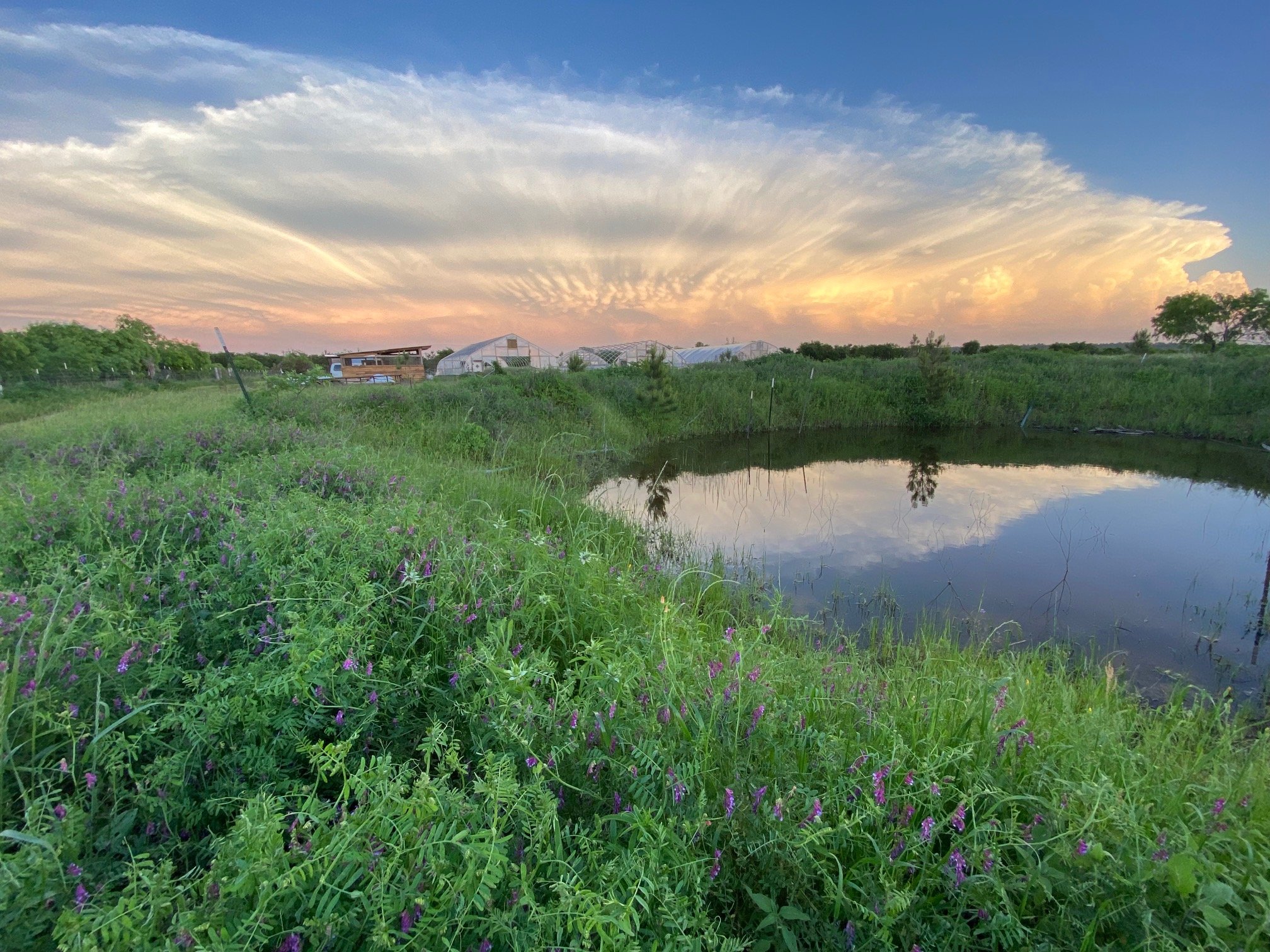Food for Thought on Earth Day
Spring Storm Passes Over Green Gate Farms
Few questions bring us closer to the essence of Earth Day than taking time to ask what we are doing or not doing for this Earth that nourishes us. Whether you are a congressman seeking input on needed changes in the farm bill or a grass-roots volunteer searching ways to improve access to land for beginning farmers, the answer grows more obvious each passing year.
“The longer we work on this issue, the more we realize that we need a paradigm shift,” said Michelle Akindiya, Farm Manager of FarmShare, a non-profit incubator for beginning farmers in Austin. “The system just isn’t working for new farmers who want to grow fresh, healthy food.”
How to shift the paradigm is what brought Rep. Greg Casar to hear from beginning farmers gathered last week at FarmShare. He heard loud and clear what the barriers are to attracting more farmers to grow local food, ranging from lack of affordable land to USDA policies that cater to big corporate farms at the expense of small family ones.
A refugee from Congo who doesn’t own a car in a city that lacks public transportation shared how she has trouble tending to her garden plot at New Leaf Farm, a farmer incubator program near Elgin that is a half-hour drive away. Another beginning farmer, who works full time while starting up his vegetable operation, lamented the lack of loans for infrastructure and equipment that would defer payment until he starts making a profit. A third grower asked how any farmer, beginning or established, can make a living when the cost for producing local food keeps rising while market prices remain so artificially low.
Back in Austin the following week, I joined other farmers as we testified to members of the Texas House Ways and Means Committee in support for HB 3857. Sponsored by Representative Thimesch, this legislation would recognize that fruits and vegetables are agriculture and that small farmers should be taxed accordingly. Texas law gives farmers the ability to pay lower property taxes, known as agricultural valuation, because of the benefits their land provides to the community, yet county tax assessors routinely deny agricultural valuation to small farmers.
Currently, Texas’s 254 counties set guidelines for valuing property tax reductions but most don’t include vegetables and often require a minimum of 10 acres before qualifying for an agricultural tax exemption.
This was my third time going to the legislature to share Green Gate Farms’ story of having to protest several times before the Bastrop Appraisal Board recognized that the county’s first certified organic vegetable farm was meeting the requirements for ag exemption. Many other small family farms are not as lucky. One state representative told the committee how established farmers had lost their ag exemption because vegetables did’t meet the county’s rigid criteria, which is based on cattle production.
“I would like those appraisers to come here and tell me vegetables aren’t food,” said one committee member who is pushing for reform.
Even a county appraiser who opposed the bill in past sessions admitted that revisions are needed to meet today’s new practices, such as indoor growing and regenerative farming.
“I’ve been doing this for 35 years but I’m starting to think we need a new approach,” he said with a long pause. “ I just don’t know what it is.”
Getting back to that Earth Day question — how we treat the land and the people who grow the food it produces — is the first place to start. Our planet has sustained the human race for thousands of years yet we all know we are pushing up against its limits. If we keep rewarding practices that take more out of the land than they put back in, nature is going to impose those limits for us, in ways we haven’t experienced in our lifetime. Indeed, as every farmer in these meetings could attest, it already has.
The paradigm that no longer serves small family farms dates back to an era when Americans were undernourished for lack of calories. Two world wars, the Great Depression and the Dust Bowl all contributed to a fragmented and inefficient food system that was losing farmers to booming cities and couldn’t meet the nutritional needs of a growing population. A half century later, thanks to farm bill policies and scientific breakthroughs, the problem with modern agriculture has flipped. Our shelves are overflowing with calorie-rich processed foods in every corner store while nutrient-dense fruits and vegetables are too often limited to farmers markets and natural food stores whose customers can afford paying the higher prices they demand.
Casar shared with the group a recent success he and Rep. Charles Booker helped pass Congress this year — capping insulin costs for diabetics at $35 per day. What wasn’t addressed, he lamented, was the paradigm that is growing diabetes in this country rather than preventing it.
How to grow more local food has been debated in Austin for enough years that we know what the barriers are. Yet like the diabetes epidemic, the numbers keep moving in the wrong direction. Only .5% of food dollars are spent on food grown in the metro area. We have fewer farmers growing local food while the population keeps swelling. Sound familiar? Meanwhile, the loss of prime farmland steadily grows — up to 16 acre a day in Travis County alone.
In nearby Bastrop County, a dozen local food leaders convened this week in Elgin to work on an innovative local food plan funded by the Texas Center for Local Food. It wasn’t lost on them that their meeting place was the first storefront in the county’s recent history dedicated to selling local produce and meat. It closed three years ago for lack of support.
Elgin Mayor Theresa McShan, who grew up on an Elgin farm, applauded the group’s efforts. She has learned late in the game how developers — not public health or food policy experts — determine what businesses will come to her town. Our current paradigm demands that it will be a McDonalds or Sonic and not a local healthy food business, despite this being a critical component to reducing diet-rated disease like diabetes.
Someone at the table asked if lack of local food options is a marketing problem or a supply problem. The answer to this chicken-or-the-egg question could be found in a recent survey conducted by others in the room. An impressive 85% of respondents said they value and want more access to locally grown food. Only 15% reported putting their local food dollars where their mouth is.
Why we continue supporting this costly, unhealthy disconnect between what we know is good for us and what we end up getting was the big unanswered question of that day in Elgin. It’s the question all of us must ask and seek answers to. Not just on Earth Day but every day.
——To learn more about legislation, local food and how you can get involved, see www.farmandranchfreedom.org

